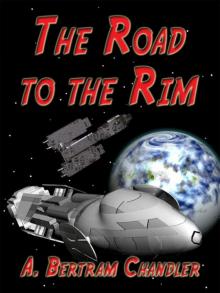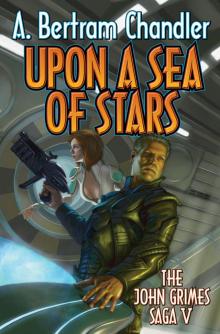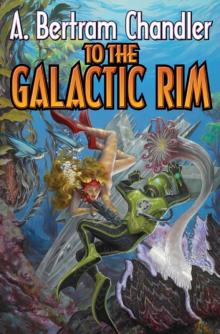- Home
- A Bertram Chandler
Upon a Sea of Stars Page 7
Upon a Sea of Stars Read online
Page 7
So . . .
So it was a dead ship, a vessel that years—or centuries—ago had fallen out of its own continuum, a ship whose crew had died, or whose descendants were no longer able to operate any of the machinery except what was essential for the maintenance of life? Or was it a ship in fighting trim manned by possibly hostile beings with itchy trigger fingers, maintaining a cautious silence until the Quest was within range of the homing missiles, the flickering laser beams?
The Commodore went to the telephone, pressed the selector stud. “Mr. Mayhew. We are closing the target. Do you hear anything?”
“No, sir.”
“The target appears to be a ship. Suppose that her Captain has ordered radio silence, what then?”
“Any unshielded mind must radiate, sir. Only trained telepaths can establish and maintain an effective shield, but even then there is leakage, a gabble of scraps of nonsense verse, meaningless mathematical formulae and the like.”
“So you think that there’s nothing living there, Mayhew?”
“I’d bet on it, sir.”
“I hope you’re right.” He snapped orders to the First Lieutenant. “Commander Swinton, take the controls, please. Match velocities with the target and maintain a range of one mile.”
“Ay, ay, sir.” And then Swinton, seating himself in the Master Pilot’s chair, was snapping his own orders, his manner assured and competent, in startling contrast to his usual callow youthfulness.
Grimes, strapped into a convenient acceleration chair, watched the young man appreciatively. He heard the whine of the stabilizing gyroscopes and felt the vibration as the ship was turned end for end—and it was odd for this maneuver to be carried out without, as a visual accompaniment, the drift of stars (even the few, faint stars of the Rim) across the viewports. And then, relatively speaking, the target was astern—astern, but still closing rapidly. Faraway Quest’s rocket drive coughed briefly, and coughed again. The target was still closing—but slowly, slowly.
For the last time there was the subdued rumble of the rockets, the gentle pressure of deceleration, and Swinton announced, not without pride, “Target abeam, sir. Velocities matched. Range one-point-oh-five of a mile.”
Grimes swiveled his chair so that he could look out of the viewports. And outside there was nothing but blackness.
In a matter of seconds the probing beam of the searchlight found the target.
It was a ship, but no ship such as any of those in the control room had ever seen. There was a long hull that looked as though the conventional torpedo shape had been sliced in two longitudinally. At one end of it there was what looked like an assemblage of control surfaces. Grimes, out of his chair and monopolizing the huge mounted binoculars, studied it carefully. There was a rudder, and there were two screw propellers. It could be, he thought, a lightjammer, similar to the ones that he himself had designed, capable of being handled in a planetary atmosphere like an airship. But the rudder was too small, and those propellers were too heavy and had too coarse a pitch to be airscrews.
But there were the lofty masts, one forward and one aft, protruding from the flat deck . . . But that would be an unusual, and not very practicable arrangement of spars to carry a lightjammer’s suite of sails. . . . And between the masts there was a structure, white-painted, that looked more like a block of apartments, complete with balconies, than part of a ship. Roughly in the middle of this there was another mast. . . . No, decided Grimes, it wasn’t a mast, it was too thick, too short. It, too, was white-painted, but with a black top, and carried a design in blue. Grimes studied it carefully, decided that it was supposed to be some sort of grapnel or anchor.
He relinquished the binoculars to Sonya Verrill. When she had had time to study the weird derelict he asked, “Well, Commander, what do you make of it?”
She replied doubtfully, “It could be a lightjammer, sir. But all those ports . . . It’d be hard enough to make a thing like that watertight, let alone airtight. . . .”
“H’m. But those ports seem to be on one half of the hull only, the half with all the odd superstructures . . . Like half a ship, and half—something else . . .”
“After all, sir,” put in Swinton, who had been studying the thing with a smaller pair of binoculars, “there’s no reason why a spaceship should be symmetrical. As long as it never has to proceed through an atmosphere it can be any shape at all that’s convenient.”
“True, Swinton. True. But if that thing’s designed for Deep Space only, why those screw propellers? Aerodynamically speaking it’s a hopeless mess, and yet it’s equipped for atmospheric flight. . . .”
“But is it?” queried Sonya Verrill. “Those absurdly heavy screws with their fantastically coarse pitch . . .”
“But where’s the planet?” asked Swinton.
“Come to that,” countered Grimes, “where’s our planet?” He added, “Who knows what odd combinations of circumstances threw us here, dropped us into this crack in Time? Who knows what similar combinations have occurred in the past?” And then, in a whisper, “But we’re such a long way from Earth . . .”
“Are we?” asked Renfrew. “Are we? What does the word ‘dimension’ mean in this dimensionless Limbo?”
“So I could be right,” said Grimes.
“What are you driving at, John?” demanded Sonya Verrill.
“I’d rather not say, yet. It’s too fantastic.” He turned to his First Lieutenant. “I’ll leave you to hold the fort, Swinton. I shall take away the boarding party.”
Chapter 14
THEY ASSEMBLED in the after airlock of Faraway Quest: Grimes, and Sonya Verrill, and Jones, and Dr. Todhunter. They waited until they were joined by Calhoun and McHenry. When the two senior engineers put in an appearance they were hung around with an assortment of tools that would have been impossible to carry in any appreciable gravitational field: hammers, and wrenches and pinch bars and burning equipment. All members of the party, of course, carried reaction pistols and, on Sonya Verrill’s insistence, all were armed—Grimes with the heavy projectile pistol that he favored, the others with hand laser projectors. In addition, the Surgeon carried a small battery of cameras.
They had put on their helmets and then Grimes, plugging the lead from his suit radio microphone into the telephone socket, ordered Swinton, in the control room, to evacuate the airlock. They watched the needle of the gauge drop slowly, finally coming to rest on Zero. And then the valve opened.
The strange ship hung out there in the absolute blackness, every detail picked out by the harsh glare of the searchlight. Her colors were bright, garish—the red that was almost purple, the broad band of pink paint, and then black, and then the white of the superstructure and the yellow of that odd assemblage of spars, of masts and booms.
She looked, thought Grimes, out of context.
But to any dweller in this nothingness—if there were any such dwellers—Faraway Quest would look out of context too.
With an odd reluctance Grimes shuffled to the sill of the airlock door, made the little jump that broke contact between his magnetic boot soles and the steel deck. His reaction pistol was ready, and with economical blasts he jetted across the mile of emptiness. And then that odd expanse of red-purple plating was before him—and with a sudden shift of orientation he had the sensation of falling toward it head first. He used his pistol to turn himself and then to brake his speed. His landing was gentle, his boot soles making contact with the metal with no more than the slightest of jars. They made contact and they held. So, he thought, this ship is made of iron, or steel. But if I am right, when she was built nobody had thought of using aluminum as a structural material, and plastics had not been dreamed of . . .
He felt the shock as Sonya Verrill landed beside him, and then Jones came in, and Todhunter, and the two engineers. Grimes waited until Calhoun and McHenry had sorted themselves out—hampered as they were by their equipment, they had fallen clumsily—and then led the way along the surface of painted metal.
It was not easy going.
A spaceman’s shuffle is a quite effective means of locomotion over a perfectly flat and smooth surface—but when the surface is made up of overlapping, riveted plates the feet must, frequently, be lifted, and there is the fear that, with magnetic contact broken, a long fall through emptiness will ensue.
But they made progress, trudging towards a near horizon that was a purple painted angle-bar, glowing dully against the blackness.
Todhunter called a halt, contorting himself so that his magnetic knee-pads touched the plating. He said, “This is odd. It looks like clumps of some sort of living organism growing on the plates. It’s dead now, of course.”
“What I expected,” Grimes told him.
“What you expected, sir?”
“If and when we get back to Port Forlorn, Doctor, you must read a few of the books in my rather specialized library. . . . I remember that a bright young journalist from the Lorn Argus once did a feature article on it. She cooked up rather a neat title, From Dug-Out Canoe to Interstellar Liner.”
“I don’t understand, sir.”
“Neither do I, Doctor. But those barnacles will keep. They’ve been keeping for one hell of a long time.”
They negotiated the angle-bar—like a ridge, it was, like the ridge of a roof with a pitch of 45 degrees—and beyond it was more of the purple-painted plating, and beyond that a stretch of pink paint, and beyond that was the dull-gleaming black. Grimes stopped at the border between the two colors, looked down at an odd, white-painted design—a circle, bisected by a line that had at one end the letter L, at the other the letter R. And from the right-hand end of this line was another line at right angles to it, and this was subdivided and lettered: IT, T, S, W, WNA. . . .
“So this is—or was—one of our ships. . . .” Sonya Verill’s voice was faint yet clear in his helmet phones. “Of course, those letters could be odd characters from some utterly alien alphabet, but they don’t look like it to me.”
“They’re not,” Grimes told her. “The L and the R stand for Lloyds’ Register. TF is Tropical Fresh, T is Tropical, S is Summer, W is Winter, and WNA is Winter North Atlantic.”
“But what does it mean? And how do you know?”
“I know because the history of shipping—all shipping—has always fascinated me. I should have recognized this ship at first glance, but I did not, because she has no right here. (But have we?) But here she is, and here we are—and we’re luckier than her people because we shall be able to survive even if we can’t find our way back . . .”
And then, still in the lead, he was shuffling over the black-painted plating until he came to a section of white-painted rails. He threw his body forward, grasped the rails with his gloved hands. He remained in this position until he had once again oriented himself, until his “up” and “down” were the “up” and “down” of the long-dead people of the dead ship. He was looking into a promenade deck. There was the scrubbed planking, and ahead of him was white-painted plating, broken by teakwood doors and brass rimmed ports—and with dense, black shadows where the glare of the Quest’s searchlights did not penetrate. With a nudge of his chin he switched on his helmet lantern; he would be needing it soon.
The wooden deck would effectively insulate his boot soles from the steel plating beneath it, so he made a scrambling leap from the rail to one of the open doorways, pulled himself into the alleyway beyond it. There were more doors—some open, some ajar and secured by stay hooks, some shut. Grimes waited until the others had joined him, then pulled himself along a sort of grab rail to the first of the partially open doors. His gloved fingers fumbled with the stay hook, finally lifted it. The door swung easily enough on its hinges, which were of polished brass.
He let himself drift into the cabin, the glare of his helmet light gleaming back at him from burnished metal, from polished wood. There was a chest of drawers, and there were two light chairs that seemed to be secured to the deck, and there were two bunks, one above the other. The upper bunk was empty.
The Commodore stared sadly at the pair of figures in the lower bunk, the man and the woman held in place by the tangle of still-white sheets. He had seen Death before, but never in so inoffensive a guise. The bodies, little more than mummies, had been drained of all moisture by their centuries-long exposure to a vacuum harder even than that of normal interstellar Space, or even that of intergalactic Space, and yet lacked the macabre qualities of the true skeleton.
Todhunter’s voice was hushed. “Do you think, sir, a photograph?”
“Go ahead, Doctor. They won’t mind.”
It’s a long time, he thought, it’s a long, long time since you minded anything. . . . But how did it come to you? Was it sudden? Did the cold get you first, or did you die when the air rushed out of your lungs in one explosive burst? He turned to look at Sonya, saw that her face was pale behind the visor of her helmet. He thought, We should be thankful. We were lucky. He said, “We shan’t learn much by looking in the other cabins.”
“Then where can we learn something?” asked Calhoun in a subdued voice.
“In the control room—although they didn’t call it that.”
He led the way along alleyways—in some of which drifted dessicated bodies—and up companionways, careful all the time to maintain the sense of orientation adapted to the derelict. Through public rooms they passed, the glare of their helmet lanterns, broken up into all the colors of the spectrum, flung back at them from the ornate crystal chandeliers. And then, at last, they came out into the open again, on to a great expansive of planking on either side of which the useless lifeboats were ranged beneath their davits. All around them was the emptiness, and there was Faraway Quest, her searchlights blazing, no more than a bright and lonely star in the black sky.
From handhold to handhold they made their way, following the Commodore, until they came to more ladders, leading to a bridge that spanned the fore part of the superstructure. In the center of this bridge was a house of varnished timber with big glass windows, and in the forward compartment of this house there was the body of a man. He was standing there, held in position by the grip of his hands on a big, spoked wheel, an ornate affair of polished wood and burnished brass. He was wearing an odd, flat blue cap, and a blue, wide-collared jumper, and blue trousers that were tucked into short black boots. The skeletal face still—after how many centuries?—wore an expression of concentration as the eyes, no more than depressions in the taut skin, stared sightlessly at the compass, at the lubber’s line that had not shifted a microsecond of arc from the quarter point in half a millenium. Eerily the card swung as Grimes looked at it, pulled away from its heading by the magnetic field generated by his suit transceiver.
Abaft the wheelhouse there was another compartment. In it were two men, both attired in uniforms that still, to a shipman, made sense. Grimes murmured, “Sorry, Captain,” and gently lifted the body of the tall, thin man, the almost-skeleton with the neat gray beard and the four gold bands on the sleeves, away from the chart table. He looked down at the chart, at the penciled courseline, at the circled intersections of cross bearings. “Yes,” he whispered. “As I thought. The South African coast . . .”
“And where is that, sir?” asked Calhoun.
“On Earth. And the time? Towards the beginning of the Twentieth Century . . .”
By his side Sonya Verrill was looking at the open pages of the Log Book. She said, “The watchkeeper recorded thunder and exceptionally vivid lightning, and also makes mention of an unusual display of phosphoresence.”
“But who were they?” Todhunter was demanding. “How did they get here?”
“I can answer the first question,” Grimes replied gravely. His gloved forefinger indicated the heading of the Log Book path. “ ‘Waratah, from Durban towards Liverpool.’ But she never got there.”
Chapter 15
THERE WERE SEVERAL BIG, glazed frames on the after bulkhead of the chartroom, and in one of them was a detailed plan of the ship. Grimes and his off
icers studied it with interest. McHenry said suddenly, “I’d like to see what their engines are like.”
“I can tell you now, Commander,” Grimes told him. “Steam. Reciprocating. Coal burning. As I remember the story, she put into Durban for bunkers on her way home from Australia.”
“But I’d like to see them, sir.” The engineer’s forefinger was tracing out a route on the plan. “As long as we keep amidships and carry on down we’re bound to come to the stokehold, and from there to the engine room.”
“Then carry on,” said Grimes. “But I don’t want you to go by yourself.”
“I shall be with him,” said Calhoun, and Jones said that he wanted to make a further exploration of the derelict, and Todhunter wanted to take more photographs.
Grimes and Sonya went out to the wing of the bridge, keeping a firm grasp on the teakwood rail, and watched the two engineers, the Second Mate and the Surgeon making their way along the boat deck, saw them open a door in the fiddley casing below and just forward of the funnel and vanish, one by one, into the black opening.
He heard the girl ask, “But how do you explain all this, John?”
“I can’t, Sonya—although this could be the explanation of a number of mysteries. As you know, I’m something of an authority on the history of shipping. You’d think that even as far back as the Twentieth Century it would be impossible to lose, completely, anything so large as a ship. After all, in those days there was quite efficient diving gear, and sonic sounding apparatus—and, even though it was in its earliest infancy, there was radio.
“But ships did vanish—and vanish without trace.
“Take this Waratah, for example. She was a new ship, owned by the Blue Anchor Line, built for the cargo-passenger trade between England and Australia. On her maiden voyage she carried freight and passengers outwards, and then loaded more freight—frozen meat and general cargo—in Australia for England, also embarking passengers. She was scheduled to call at Durban on the homeward passage to replenish her coal bunkers, also to disembark and to embark passengers. One odd feature of the voyage was the number of intending travelers who experienced premonitory dreams of a warning character and, as a result of these, canceled their passages.

 Into the Alternate Universe
Into the Alternate Universe The Alternate Martians
The Alternate Martians The Inheritors
The Inheritors Contraband From Otherspace
Contraband From Otherspace Ride the Star Winds
Ride the Star Winds Catch the Star Winds
Catch the Star Winds Spartan Planet
Spartan Planet Up to the Sky in Ships
Up to the Sky in Ships The Hard Way Up
The Hard Way Up The Gateway to Never
The Gateway to Never The Broken Cycle
The Broken Cycle The Coils of Time
The Coils of Time Gateway to Never (John Grimes)
Gateway to Never (John Grimes) To Prime the Pump
To Prime the Pump The Hamelin Plague
The Hamelin Plague The Big Black Mark
The Big Black Mark Frontier of the Dark
Frontier of the Dark Alternate Orbits
Alternate Orbits The Way Back
The Way Back The Road to the Rim
The Road to the Rim Upon a Sea of Stars
Upon a Sea of Stars The Dark Dimensions
The Dark Dimensions First Command
First Command To the Galactic Rim: The John Grimes Saga
To the Galactic Rim: The John Grimes Saga The Rim Gods
The Rim Gods Galactic Courier: The John Grimes Saga III
Galactic Courier: The John Grimes Saga III Glory Planet
Glory Planet